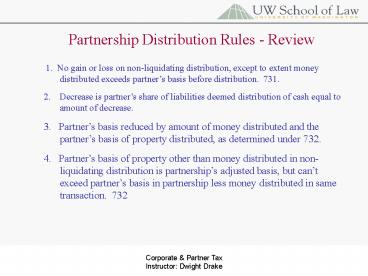Partnership Distribution Rules - Review PowerPoint PPT Presentation
1 / 12
Title: Partnership Distribution Rules - Review
1
Partnership Distribution Rules - Review
1. No gain or loss on non-liquidating
distribution, except to extent money distributed
exceeds partners basis before distribution.
731. 2. Decrease is partners share of
liabilities deemed distribution of cash equal to
amount of decrease. 3. Partners basis reduced
by amount of money distributed and the partners
basis of property distributed, as determined
under 732. 4. Partners basis of property other
than money distributed in non-liquidating
distribution is partnerships adjusted basis, but
cant exceed partners basis in partnership less
money distributed in same transaction. 732
2
Special Allocation Items
1. Bottom line losses of partnership 2.
Bottom line income of partnership 3. Specialty
income items - Tax-exempt interest
- Built-in gain on contributed items per
704(c) - Gains or losses on specific
assets - Royalties or special income
items 4. Special deduction items -
Depreciation - Charitable contributions
- RD and other extraordinary expense
items.
3
Special Allocations
Big Question When will they work
for tax purposes?
4
The 704 Rules
704(a) Partners share of income, gain,
loss deduction or credit determined by
partnership agreement unless otherwise provided
in Subchapter K 704(b) Partners share of
all items determined by partners interest in
partnership, based on all facts and
circumstances, if - The
partnership agreement does not spell out
allocations, or - Partnership
agreement lays out allocation, but it does not
have substantial economic effect. Hence,
big issue What is substantial economic
effect?
5
Economic Effect Safe Harbor
Three elements 1. Capital accounts
maintained for each partner per Reg.
1.704-1(b)(2)(iv). 2. Upon liquidation
of partnership or any partners interest,
distributions made in accordance with positive
balances in capital accounts. 3.
Partner with negative balance in account after
liquidation has unconditional obligation to
restore by later of end of year or 90 days after
liquidation.
6
Capital Account Maintenance Per 704 Regs.
Increase by - Amount of money
contributed by partner - FMV of property
contributed by partner - Allocations of
partnership income or gain, including tax-exempt
income. Decrease by - Amount of money
distributed to partner - FMV of property
distributed to partner - Allocations to
partner of expenditures that are neither
deductible not capitalized (gambling losses,
bribes, charitable contributions, related-party
losses, etc) - Allocations of partnership
losses and deduction items Note Looks like
outside basis, but not the same.
7
Example of Three Element Safe Harbor
Basic Facts A B contribute 15k cash to AB
partnership. Starting balance sheet and capital
accounts as follows Assets Cash
30k
Total Assets 30k
Liabilities
0 A Capital account
15k B Capital account
15k Total Capital
30k
8
Example of Three Element Safe Harbor
Basic Facts Year 1, partnership losses 10k
Year 2, partnership losses 10k. Agreement
provides losses allocated 90 to A, 10 to B.
Assets
Starting Year 1 Year 2
Cash
30k 20k 10k
Total Assets 30k
20k 10k
Liabilities
0 A Capital account 15k
6k (15-9) -3k (6-9) B
Capital account 15k
14k (15-1) 13k (14-1) Total
Capital 30k
20k 10k
9
Example of Three Element Safe Harbor
If liquidate at the end of year 2 with
agreement that says allocate all liquidation
proceeds 50-50, what happens? - A
B each get 5k? - A books losses of
18k, but really only lost 10k (15-5). Thus, 8k
of As losses never had any economic effect.
They never cost A anything. So, those losses not
allowed under 704(b). If liquidate at end of
year two with safe harbor clauses -
All 10k of assets paid to B because B is only
partner with positive capital account. -
A would have to contribute 3k to make up
deficit. - 3k contributed by A would be
paid to B to zero B capital account. Thus, B
ends up getting 13k, full capital account
balance. - 18k losses allocated to A
had economic effect because A paid in end.
10
The Alternative to Deficit Restoration
Situation Partner wants special
allocation, but no deficit restoration risk
Alternative Safe Harbor - First
two elements of present Maintain capital
accounts and distribute liquidation proceeds in
accordance with positive capital account
balances. - Agreement contains
Qualified Income Offset.
11
Qualified Income Offset
Sample Provision If at the end
of any taxable year any Partner shall have a
negative balance in such Partners Deemed Capital
Account, then notwithstanding anything herein to
the contrary, there shall be reallocated to each
such Partner each item of Company gross income
(unreduced by any deductions) and gain in
proportion to such negative balance until the
Deemed Capital Account of such Partner is
increased to zero. So what is Deemed
Capital Account? Capital account adjusted by
reasonably expected future distributions that
exceed corresponding capital account increases
and other items to come.
12
Example Under Alternative with Qualified Income
Offset
Year One Capital accounts all positive, so
no problem. Year Two As account goes
negative by 3k. Gross income of 3k reallocated
to A to take As account to zero. Effect on B is
a bigger share of loss by 3k, so Bs capital
account goes to 10k from 13k. Economic
effect test If liquidate at end of Year 2, all
10k assets would go to B, only partner with
positive balance. This would equal balance in
As account. A would not have to restore a
deficit. Extra losses allocated to A would have
had economic effect because A gets nothing on
liquidation.

